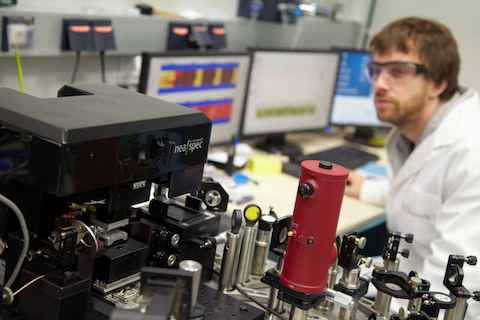Infrared nanospectroscopy and hyperspectral nanoimaging of organic matter
Iban Amenabar, Pre-doctoral Researcher at the Nanooptics Group at CIC nanoGUNE, received his PhD at the University of the Basque Country (UPV/EHU) after the defense of his thesis project on 12 July 2017. His research work, entitled “ Infrared nanospectroscopy and hyperspectral nanoimaging of organic matter", has been developed under the supervision of Dr. Rainer Hillenbrand, Nanootpics group leader.
An international committee including leading researchers in the field was selected to assess the research project:
- Dr. Thomas Taubner (Institute of Organic Chemistry RWTH)
- Dr. Juan José Saenz-Gutierrez (DIPC)
- Dr. Francisco Javier Aizpurua Iriazabal (UPV/EHU)
The defense consisted of a presentation by the candidate on the main aspects of the Ph.D. thesis project followed by an extended discussion based upon the questions that each one of the members of the committee raised in relation to the research work that has been carried out by Iban Amenabar during his PhD studies. After its final deliberation, the committee decided to award the candidate the Doctor Degree with the highest mention existing at UPV/EHU (cum laude).

After the defense, we asked Dr. Iban Amenabar to explain us a bit more about his project:
Which was the subject of your thesis?
My thesis was about near-field infrared microscopy and spectroscopy of organic matter. To this end, I used the scattering type scanning optical microscopy (s-SNOM) and the Fourier transform infrared nanospectroscopy (nano-FTIR) techniques. In the first part, I employed the already existing two techniques to set the foundations for nanospectroscopy of proteins. I improved the nano-FTIR technique and studied its potential for the nanoscale analysis of proteins; spatial resolution, sensitivity, orientation dependence, secondary structure mapping, etc. In the second part, I further developed the technique and achieved hyperspectral infrared nanimaging. We developed this new technique and applied in two relevant applications.
Why did you choose this subject?
Before I was working in a research center of IK4 and I was working in a project dealing with THz radiation. I liked the field of optics, and though I didn’t have the typical background on Physics, I decided to move my professional career towards optics. I learned about the PhD position in nanooptics available at NanoGUNE and I decided to go for it.
Which methodology/techniques did you use?
I used basically only the Scattering type scanning near-field optical microscope s-SNOM, and I focused on improving and applying this technique.
Which have been the main conclusions?
In the first part we concluded that near field microscopy allows for recording infrared spectra of one single ferritin protein complex (i.e. about 1 attogram), we showed that this technique is sensitive only to vibrations perpendicular to the substrate and its spatial resolution is of about 30 nm. Most importantly, we showed that it can be interpreted in the framework of FTIR spectroscopy and it provides information about the secondary structure of proteins at the nanoscale. In the second part, we showed that with the current microscopes it is possible to record hyperspectral infrared nanoimages in a reasonable time of few hours, and we showed that new insights about relevant applications (ej, polymer blends) can be extracted from such images.
What could be the contribution of your research for present or future nanotechnologies?
We showed that near field microscopy is an still evolving technique, which already in its current status can be applied to provide relevant insights in real applications; ej. polymer industry, biology, medicine, pharmaceutics, etc.
How do you feel now that you have finished the thesis?
I feel like I experienced how science works and how it feels like working in science. Right now, I plan to stay in nanoGUNE to try to set up a service platform that aims in applying our technique in real industrial problems.
